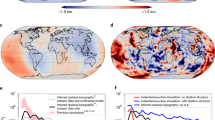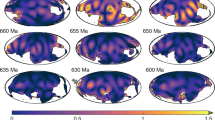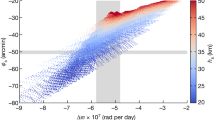Abstract
Several lines of evidence suggest that Saturn’s largest moon, Titan, has a global subsurface ocean beneath an outer ice shell 50 to 200 kilometres thick1,2,3,4. If convection5,6 is occurring, the rigid portion of the shell is expected to be thin; similarly, a weak, isostatically compensated shell has been proposed7,8 to explain the observed topography. Here we report a strong inverse correlation between gravity3 and topography9 at long wavelengths that are not dominated by tides and rotation. We argue that negative gravity anomalies (mass deficits) produced by crustal thickening at the base of the ice shell overwhelm positive gravity anomalies (mass excesses) produced by the small surface topography, giving rise to this inverse correlation. We show that this situation requires a substantially rigid ice shell with an elastic thickness exceeding 40 kilometres, and hundreds of metres of surface erosion and deposition, consistent with recent estimates from local features10,11. Our results are therefore not compatible with a geologically active, low-rigidity ice shell. After extrapolating to wavelengths that are controlled by tides and rotation, we suggest that Titan’s moment of inertia may be even higher (that is, Titan may be even less centrally condensed) than is currently thought12.
This is a preview of subscription content, access via your institution
Access options
Subscribe to this journal
Receive 51 print issues and online access
$199.00 per year
only $3.90 per issue
Buy this article
- Purchase on Springer Link
- Instant access to full article PDF
Prices may be subject to local taxes which are calculated during checkout



Similar content being viewed by others
References
Béghin, C., Sotin, C. & Hamelin, M. Titan’s native ocean revealed beneath some 45 km of ice by a Schumann-like resonance. C. R. Geosci. 342, 425–433 (2010)
Bills, B. G. & Nimmo, F. Rotational dynamics and internal structure of Titan. Icarus 214, 351–355 (2011)
Iess, L. et al. The tides of Titan. Science 337, 457–459 (2012)
Tobie, G., Lunine, J. I. & Sotin, C. Episodic outgassing as the origin of atmospheric methane on Titan. Nature 440, 61–64 (2006)
Mitri, G. & Showman, A. P. Thermal convection in ice-I shells of Titan and Enceladus. Icarus 193, 387–396 (2008)
Tobie, G., Grasset, O., Lunine, J. I., Mocquet, A. & Sotin, C. Titan’s internal structure inferred from a coupled thermal-orbital model. Icarus 175, 496–502 (2005)
Nimmo, F. & Bills, B. G. Shell thickness variations and the long-wavelength topography of Titan. Icarus 208, 896–904 (2010)
Choukroun, M. & Sotin, C. Is Titan’s shape caused by its meteorology and carbon cycle? Geophys. Res. Lett. 39, 1–5 (2012)
Zebker, H. A. et al. Titan’s figure fatter, flatter than its gravity field. AGU Fall Meet. abstr. P23F–01. (2012)
Neish, C. D. et al. Crater topography on Titan: implications for landscape evolution. Icarus 223, 82–90 (2013)
Moore, J. M., Howard, A. D. & Schenk, P. M. Bedrock denudation on Titan: estimates of vertical extent and lateral debris dispersion. Lunar Planet. Sci. Conf. XXXXIIII, abstr. 1763. (2013)
Iess, L. et al. Gravity field, shape, and moment of inertia of Titan. Science 327, 1367–1369 (2010)
Stiles, B. W. et al. Determining Titan surface topography from Cassini SAR data. Icarus 202, 584–598 (2009)
Zebker, H. et al. Size and shape of Saturn’s moon Titan. Science 324, 921–923 (2009)
McKenzie, D. The relationship between topography and gravity on Earth and Venus. Icarus 112, 55–88 (1994)
Wieczorek, M. A. Gravity and topography of the terrestrial planets. Treat. Geophys. 10, 165–206 (2007)
Richards, M. A. & Hager, B. H. Geoid anomalies in a dynamic Earth. J. Geophys. Res. 89, 5987–6002 (1984)
Roberts, J. H. & Nimmo, F. Tidal heating and the long-term stability of a subsurface ocean on Enceladus. Icarus 194, 675–689 (2008)
Kraus, H. Thin Elastic Shells (Wiley, 1967)
Turcotte, D. L., Willemann, R. J., Haxby, W. F. & Norberry, J. Role of membrane stresses in the support of planetary topography. J. Geophys. Res. 86, 3951–3959 (1981)
McGovern, P. J. et al. Localized gravity/topography admittance and correlation spectra on Mars: implications for regional and global evolution. J. Geophys. Res. 107 5136 (2002)
Moore, J. M. & Pappalardo, R. T. Titan: an exogenic world? Icarus 212, 790–806 (2011)
Grasset, O., Sotin, C. & Deschamps, F. On the internal structure and dynamics of Titan. Planet. Space Sci. 48, 617–636 (2000)
Lopes, R. M. C. et al. Cryovolcanic features on Titan’s surface as revealed by the Cassini Titan Radar Mapper. Icarus 186, 395–412 (2007)
Běhounková, M., Tobie, G., Choblet, G. & Čadek, O. Tidally-induced melting events as the origin of south-pole activity on Enceladus. Icarus 219, 655–664 (2012)
Nimmo, F. Non-Newtonian topographic relaxation on Europa. Icarus 168, 205–208 (2004)
Black, B. A., Perron, J. T., Burr, D. M. & Drummond, S. A. Estimating erosional exhumation on Titan from drainage network morphology. J. Geophys. Res. 117 E08006 (2012)
Patterson, D. B., Farley, K. A. & Norman, M. D. He-4 as a tracer of continental dust: a 1.9 million year record of aeolian flux to the west equatorial Pacific Ocean. Geochim. Cosmochim. Acta 63, 615–625 (1999)
O’Rourke, J. G. & Stevenson, D. J. Stability of ice/rock mixtures with applications to Titan. Lunar Planet. Sci. Conf. XXXXII, abstr. 1629 (2011)
Acknowledgements
We thank the Cassini radar science team, M. Manga, D. Stevenson, R. Pappalardo and W. McKinnon for their suggestions. Portions of this work were supported by NASA grants NNX13AG02G and NNX11AK44G.
Author information
Authors and Affiliations
Contributions
F.N. initiated the effort. D.H. and F.N. developed the loading models and analysed the results. L.I. led the development of the gravity field models. H.Z. synthesized the topography models. All authors discussed the results and implications and commented on the manuscript.
Corresponding author
Ethics declarations
Competing interests
The authors declare no competing financial interests.
Supplementary information
Supplementary Information
This file contains Supplementary Text and Data, Supplementary Figures 1-11, Supplementary Tables 1-4 and Supplementary References. (PDF 1639 kb)
Rights and permissions
About this article
Cite this article
Hemingway, D., Nimmo, F., Zebker, H. et al. A rigid and weathered ice shell on Titan. Nature 500, 550–552 (2013). https://doi.org/10.1038/nature12400
Received:
Accepted:
Published:
Issue Date:
DOI: https://doi.org/10.1038/nature12400
This article is cited by
-
Exploring the Interior of Europa with the Europa Clipper
Space Science Reviews (2023)
-
Science goals and new mission concepts for future exploration of Titan’s atmosphere, geology and habitability: titan POlar scout/orbitEr and in situ lake lander and DrONe explorer (POSEIDON)
Experimental Astronomy (2022)
-
Ice-Ocean Exchange Processes in the Jovian and Saturnian Satellites
Space Science Reviews (2020)
-
Large Ocean Worlds with High-Pressure Ices
Space Science Reviews (2020)
-
Possible Atmospheric Diversity of Low Mass Exoplanets – Some Central Aspects
Space Science Reviews (2020)
Comments
By submitting a comment you agree to abide by our Terms and Community Guidelines. If you find something abusive or that does not comply with our terms or guidelines please flag it as inappropriate.



